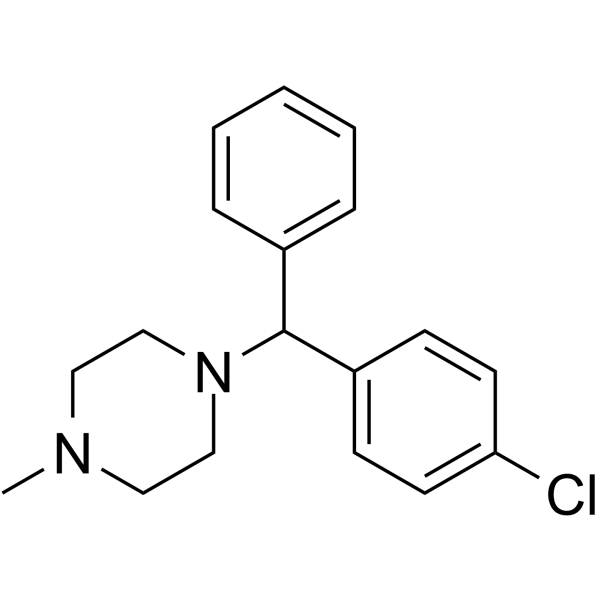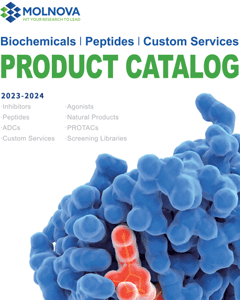
Chlorcyclizine
CAS No. 82-93-9
Chlorcyclizine( 1-((4-chlorophenyl)(phenyl)Methyl)-4-Methylpiperazine )
Catalog No. M28856 CAS No. 82-93-9
CHLORCYCLIZINE is a histamine H1 antagonist and a potent hepatitis C virus (HCV) entry inhibitor.
Purity : >98% (HPLC)
 COA
COA
 Datasheet
Datasheet
 HNMR
HNMR
 HPLC
HPLC
 MSDS
MSDS
 Handing Instructions
Handing Instructions
| Size | Price / USD | Stock | Quantity |
| 50MG | 55 | Get Quote |


|
| 100MG | Get Quote | Get Quote |


|
| 200MG | Get Quote | Get Quote |


|
| 500MG | Get Quote | Get Quote |


|
| 1G | Get Quote | Get Quote |


|
Biological Information
-
Product NameChlorcyclizine
-
NoteResearch use only, not for human use.
-
Brief DescriptionCHLORCYCLIZINE is a histamine H1 antagonist and a potent hepatitis C virus (HCV) entry inhibitor.
-
DescriptionCHLORCYCLIZINE is a histamine H1 antagonist and a potent hepatitis C virus (HCV) entry inhibitor.(In Vivo):Pregnant rats were administered 30, 60, or 90 mg/kg CHLORCYCLIZINE on Gestation Days 11 to 14. Fetal palate gene expression was also assessed after 90 mg/kg CHLORCYCLIZINE at 8, 15 and 30 hours post-dose on Gestation Day 14 using microarray and qRT-PCR. Rats in the 60- and 90-mg/kg groups exhibited adverse clinical signs and body weight loss. Rats in the 90-mg/kg group also demonstrated increases in late resorptions and decreases in fetal weight. Effects in the low-dose group were limited to decreases in body weight gain. Fetal assessment on Gestation Day 21 revealed that findings were limited to the 60- and 90-mg/kg groups, and included cleft palate (80% of litters for both groups), high arched palate, small nose, micrognathia, high domed head, digits shortened/absent and small limb. The fetal incidence of cleft palate was higher at 90 mg/kg, thus this dose was selected to assess palate gene expression. The altered genes associated with CHLORCYCLIZINE-induced cleft palate included Wnt5a, Bmp2, Bmp4, Fgf10, Fgfr2, Msx1, and Insig1 but the magnitude of the change was relatively small (1.5- to 2-fold).
-
In Vitro——
-
In VivoPregnant rats administered 30, 60, and 90mg/kg Chlorcyclizine during the sensitive period for palate development survived until scheduled sacrifice on Gestation Days (GDs) 17 or 21. The rats administered 60 or 90mg/kg Chlorcyclizine have transient adverse clinical signs (chromorhinorrhea, red peri-oral substance, urogenital staining, and scant stool) and a concomitant body weight loss of 7% and 11%, respectively, over the dosing interval. Rats administered 30mg/kg Chlorcyclizine do not exhibit any adverse clinical signs, but do not gain weight over the dose interval as would be expected during pregnancy. Based on the testing facility’s historical control database (16 studies, n=380). pregnant rats typically gain about 6% body weight from GDs 12 to 15.
-
Synonyms1-((4-chlorophenyl)(phenyl)Methyl)-4-Methylpiperazine
-
PathwayMicrobiology/Virology
-
TargetHCV
-
Recptor——
-
Research Area——
-
Indication——
Chemical Information
-
CAS Number82-93-9
-
Formula Weight300.83
-
Molecular FormulaC18H21ClN2
-
Purity>98% (HPLC)
-
Solubility——
-
SMILESCN(CC1)CCN1C(c1ccccc1)c(cc1)ccc1Cl
-
Chemical Name——
Shipping & Storage Information
-
Storage(-20℃)
-
ShippingWith Ice Pack
-
Stability≥ 2 years
Reference
1.Qin M, et al. Discovery of [1,2,4]Triazolo[4,3- a]pyridines as Potent Inhibitors Targeting the Programmed Cell Death-1/Programmed Cell Death-Ligand 1 Interaction. J Med Chem. 2019 May 9;62(9):4703-4715.
molnova catalog



related products
-
Dasabuvir
ABT-333 is an NS5B non-nucleoside polymerase inhibitor.
-
Sovaprevir
Sovaprevir (ACH-1625, ACH-0141625) is a potent HCV NS3/4A inhibitor in development for the treatment of hepatitis C.
-
Telaprevir
A potent, selective, covalent, orally bioavailable inhibitor of HCV NS3/4A protease with Ki of 7 nM.



 Cart
Cart
 sales@molnova.com
sales@molnova.com


